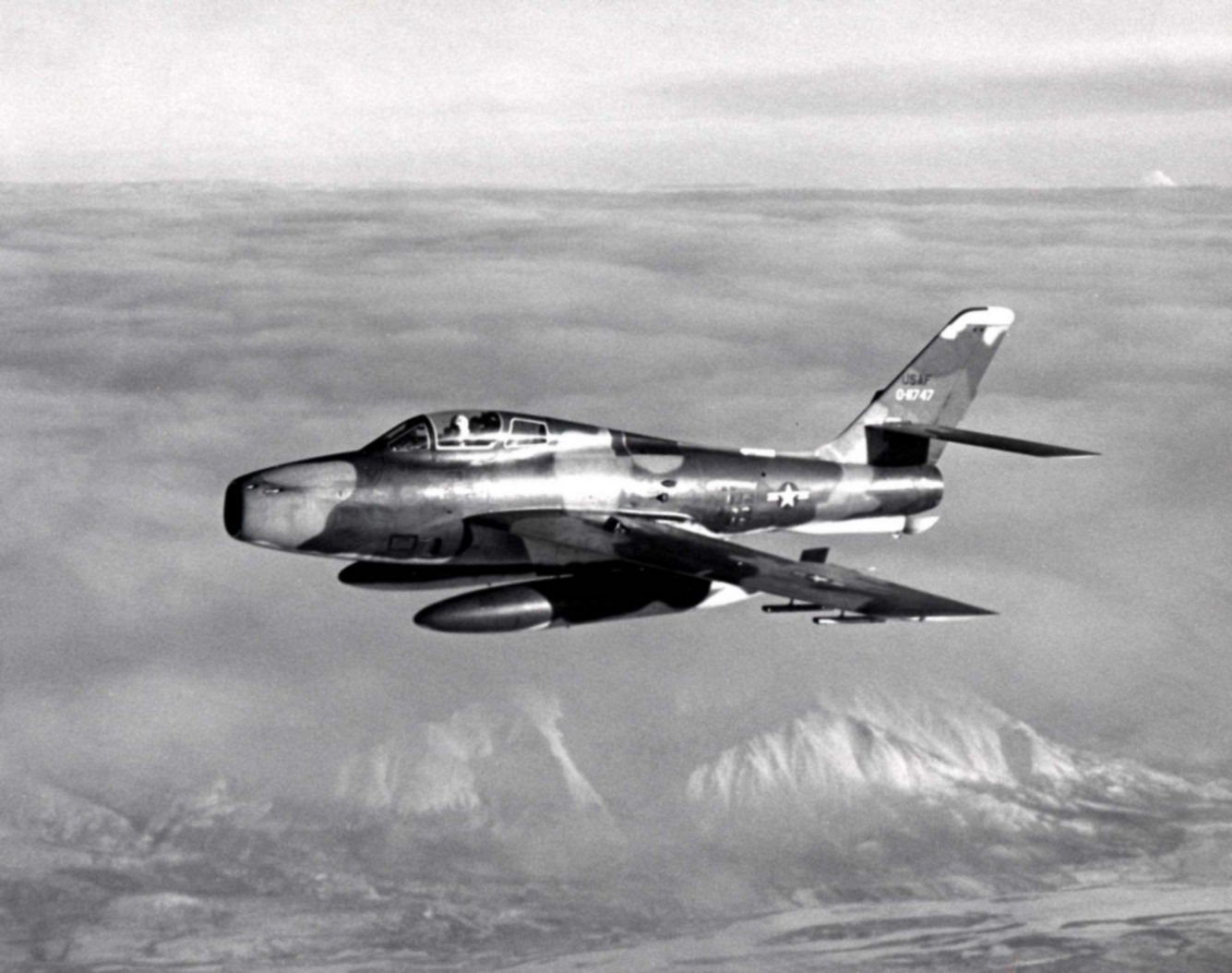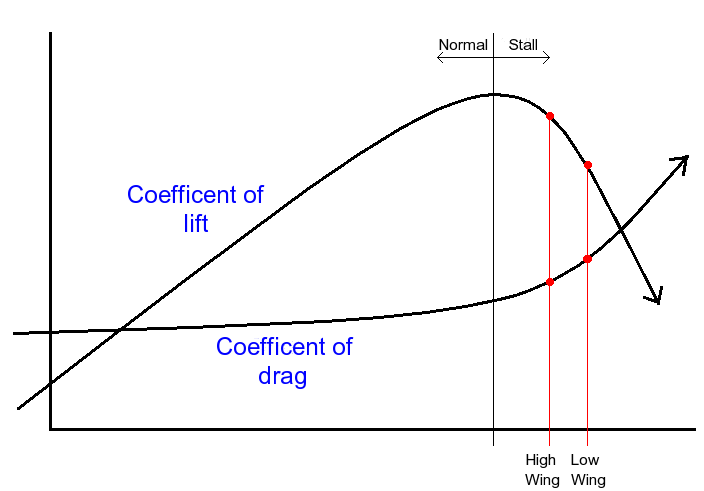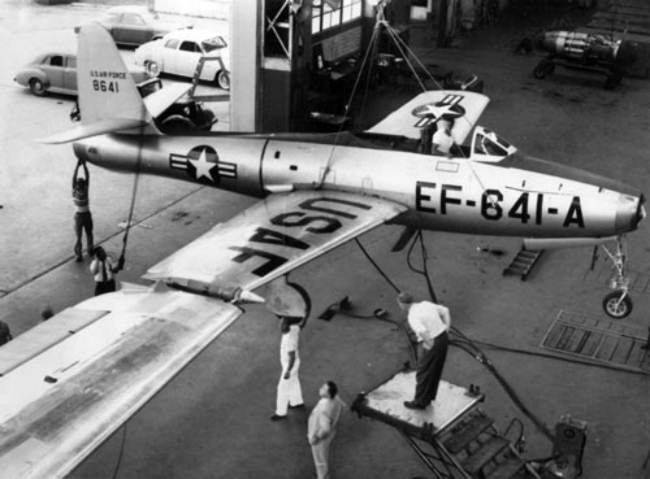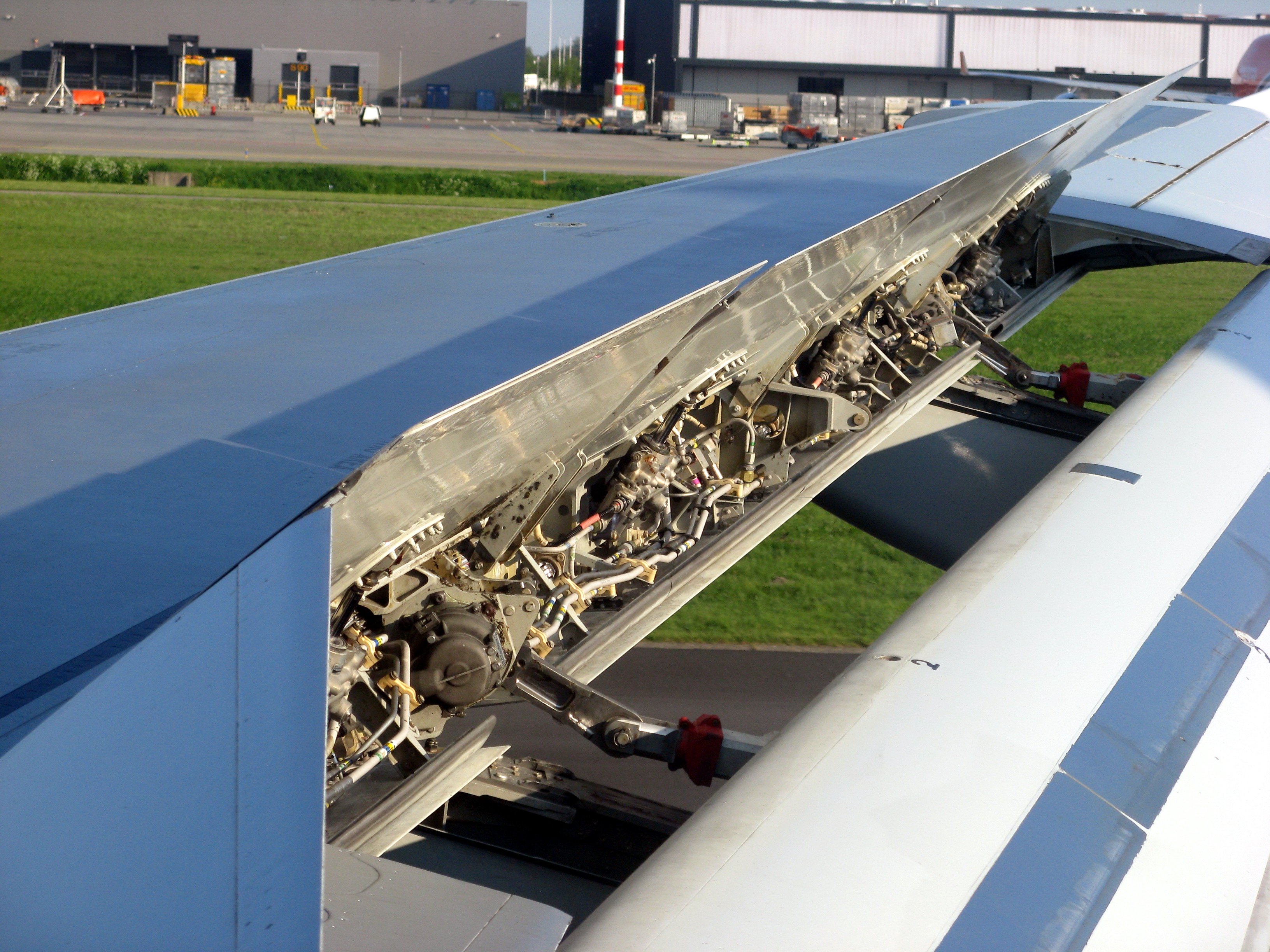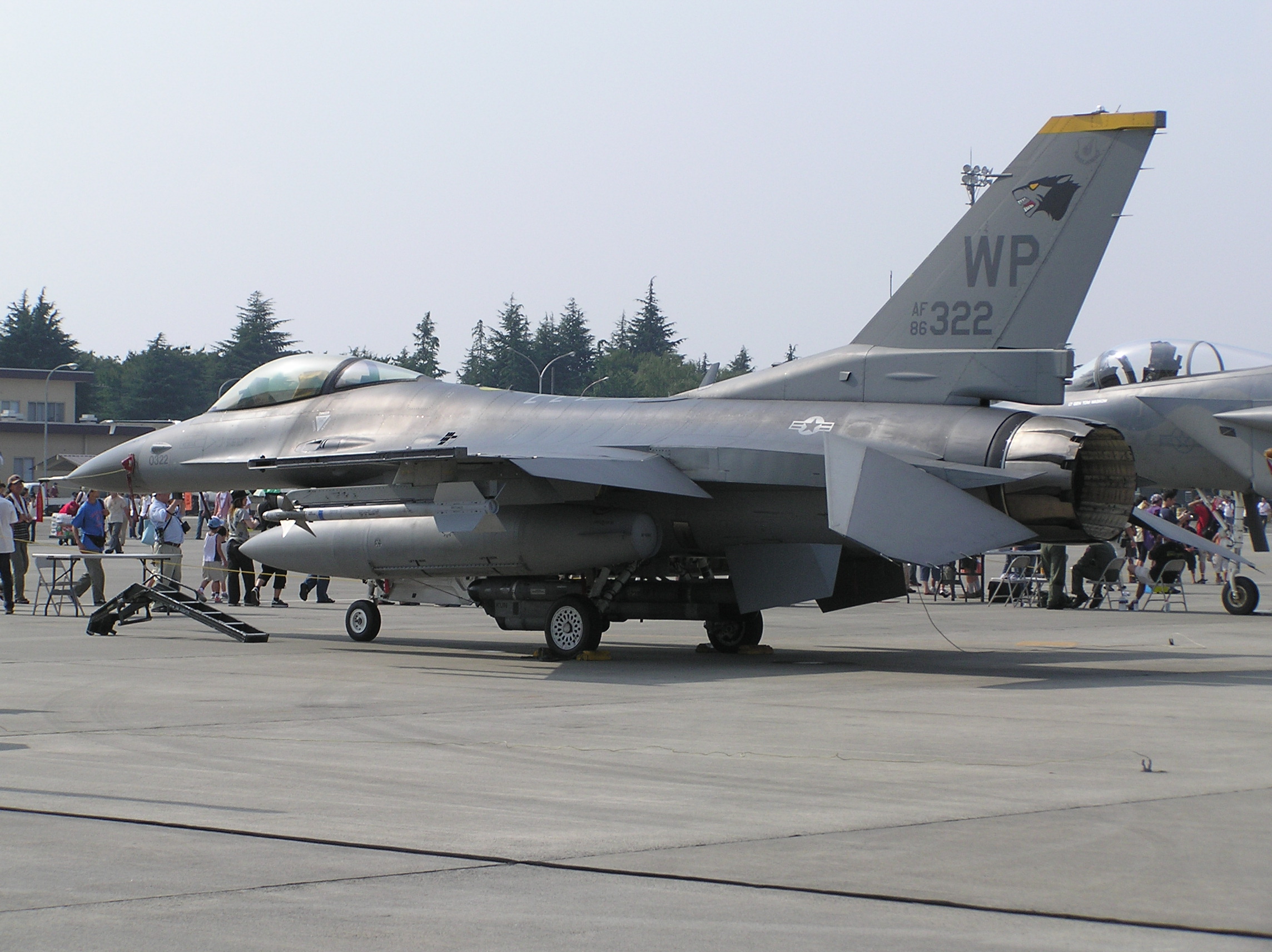|
F-84 Thunderstreak
The Republic F-84F Thunderstreak was an American swept-wing turbojet fighter-bomber. While an evolutionary development of the straight-wing F-84 Thunderjet, the F-84F was a new design. The RF-84F Thunderflash was a photo reconnaissance version. Development In 1948, a swept wing version of the F-84 was created with the hope of bringing performance to the level of the F-86. The last production F-84E was fitted with a swept tail, a new wing with 38.5 degrees of leading edge sweep and 3.5 degrees of anhedral, and a J35-A-25 engine producing 5,300 pound-force (23.58 kN) of thrust.Knaack 1978, p. 42. The aircraft was designated XF-96A. It flew on 3 June 1950 with Oscar P. Haas at the controls. Although the airplane was capable of 602 knots (693 mph, 1,115 km/h), the performance gain over the F-84E was considered minor. Nonetheless, it was ordered into production in July 1950 as the F-84F Thunderstreak. The F-84 designation was retained because the ... [...More Info...] [...Related Items...] OR: [Wikipedia] [Google] [Baidu] |
WikiProject Aircraft
A WikiProject, or Wikiproject, is a Wikimedia movement affinity group for contributors with shared goals. WikiProjects are prevalent within the largest wiki, Wikipedia, and exist to varying degrees within sister projects such as Wiktionary, Wikiquote, Wikidata, and Wikisource. They also exist in different languages, and translation of articles is a form of their collaboration. During the COVID-19 pandemic, CBS News noted the role of Wikipedia's WikiProject Medicine in maintaining the accuracy of articles related to the disease. Another WikiProject that has drawn attention is WikiProject Women Scientists, which was profiled by '' Smithsonian'' for its efforts to improve coverage of women scientists which the profile noted had "helped increase the number of female scientists on Wikipedia from around 1,600 to over 5,000". On Wikipedia Some Wikipedia WikiProjects are substantial enough to engage in cooperative activities with outside organizations relevant to the field at issue. For e ... [...More Info...] [...Related Items...] OR: [Wikipedia] [Google] [Baidu] |
Allison J35
The General Electric/Allison J35 was the United States Air Force's first axial-flow (straight-through airflow) compressor jet engine. Originally developed by General Electric (GE company designation TG-180) in parallel with the Whittle-based centrifugal-flow J33, the J35 was a fairly simple turbojet, consisting of an eleven-stage axial-flow compressor and a single-stage turbine. With the afterburner, which most models carried, it produced a thrust of . Like the J33, the design of the J35 originated at General Electric, but major production was by the Allison Engine Company. Design and development While developing the T31 axial turboprop in 1943 General Electric realized that they had the resources to design an axial flow turbojet at the same time as their centrifugal-flow J33 engine. They recognized the axial would have more potential for the future and went ahead with the TG-180 engine. GE axial compressor designs were developed from the NACA 8-stage compressor. The e ... [...More Info...] [...Related Items...] OR: [Wikipedia] [Google] [Baidu] |
F-84F Thunderbirds
The Republic F-84F Thunderstreak was an American swept-wing turbojet fighter-bomber. While an evolutionary development of the straight-wing F-84 Thunderjet, the F-84F was a new design. The RF-84F Thunderflash was a photo reconnaissance version. Development In 1948, a swept wing version of the F-84 was created with the hope of bringing performance to the level of the F-86. The last production F-84E was fitted with a swept tail, a new wing with 38.5 degrees of leading edge sweep and 3.5 degrees of anhedral, and a J35-A-25 engine producing 5,300 pound-force (23.58 kN) of thrust.Knaack 1978, p. 42. The aircraft was designated XF-96A. It flew on 3 June 1950 with Oscar P. Haas at the controls. Although the airplane was capable of 602 knots (693 mph, 1,115 km/h), the performance gain over the F-84E was considered minor. Nonetheless, it was ordered into production in July 1950 as the F-84F Thunderstreak. The F-84 designation was retained because the ... [...More Info...] [...Related Items...] OR: [Wikipedia] [Google] [Baidu] |
F-84F 162nd FS Ohio ANG In Flight 1960s
The Republic F-84F Thunderstreak was an American swept-wing turbojet fighter-bomber. While an evolutionary development of the straight-wing Republic F-84 Thunderjet, F-84 Thunderjet, the F-84F was a new design. The RF-84F Thunderflash was a Aerial reconnaissance, photo reconnaissance version. Development In 1948, a swept wing version of the F-84 was created with the hope of bringing performance to the level of the North American F-86 Sabre, F-86. The last production F-84E was fitted with a swept tail, a new wing with 38.5 degrees of leading edge sweep and 3.5 degrees of dihedral (aircraft), anhedral, and a Allison J35, J35-A-25 engine producing 5,300 pound-force (23.58 kN) of thrust.Knaack 1978, p. 42. The aircraft was designated XF-96A. It flew on 3 June 1950 with Oscar P. Haas at the controls. Although the airplane was capable of 602 knots (693 mph, 1,115 km/h), the performance gain over the F-84E was considered minor. Nonetheless, it was ord ... [...More Info...] [...Related Items...] OR: [Wikipedia] [Google] [Baidu] |
Spin (aerodynamics)
In flight dynamics a spin is a special category of stall resulting in autorotation (uncommanded roll) about the aircraft's longitudinal axis and a shallow, rotating, downward path approximately centred on a vertical axis. Spins can be entered intentionally or unintentionally, from any flight attitude if the aircraft has sufficient yaw while at the stall point. In a normal spin, the wing on the inside of the turn stalls while the outside wing remains flying. It is possible for both wings to stall, but the angle of attack of each wing, and consequently its lift and drag, are different. Either situation causes the aircraft to autorotate toward the stalled wing due to its higher drag and loss of lift. Spins are characterized by high angle of attack, an airspeed below the stall on at least one wing and a shallow descent. Recovery and avoiding a crash may require a specific and counter-intuitive set of actions. A spin differs from a spiral dive, in which neither wing is stalled an ... [...More Info...] [...Related Items...] OR: [Wikipedia] [Google] [Baidu] |
FICON Project
The FICON (Fighter Conveyor) program was conducted by the United States Air Force in the 1950s to test the feasibility of a Convair B-36 Peacemaker bomber carrying a Republic F-84 Thunderflash parasite fighter in its bomb bay. Earlier wingtip coupling experiments included Tip Tow, which were attempts at carrying fighters connected to the wingtips of bombers. Tom-Tom followed the FICON project afterwards. Background Wingtip coupling experiments Wingtip coupling experiments were evolved from the concept of adding extra floating panels to extend the effective wingspan of an aircraft, in the hope this would extend the range of the aircraft. This would theoretically act in the same manner as the long narrow wings of a glider. It is reported that the Germans experimented with the idea in 1944 and 1945 by coupling two equal-sized light planes together, then the idea was further developed by Richard Vogt, who came to the US from Germany after World War II. The idea was tested at Wrigh ... [...More Info...] [...Related Items...] OR: [Wikipedia] [Google] [Baidu] |
15th Tactical Reconnaissance Squadron Republic RF-84F-30-RE Thunderflash 52-7412
15 (fifteen) is the natural number following 14 and preceding 16. Mathematics 15 is: * A composite number, and the sixth semiprime; its proper divisors being , and . * A deficient number, a smooth number, a lucky number, a pernicious number, a bell number (i.e., the number of partitions for a set of size 4), a pentatope number, and a repdigit in binary (1111) and quaternary (33). In hexadecimal, and higher bases, it is represented as F. * A triangular number, a hexagonal number, and a centered tetrahedral number. * The number of partitions of 7. * The smallest number that can be factorized using Shor's quantum algorithm. * The magic constant of the unique order-3 normal magic square. * The number of supersingular primes. Furthermore, * 15 is one of two numbers within the ''teen'' numerical range (13-19) not to use a single-digit number in the prefix of its name (the first syllable preceding the ''teen'' suffix); instead, it uses the adjective form of five (' ... [...More Info...] [...Related Items...] OR: [Wikipedia] [Google] [Baidu] |
Spoiler (aeronautics)
In aeronautics, a spoiler (sometimes called a lift spoiler or lift dumper) is a device which intentionally reduces the lift (force), lift component of an airfoil in a controlled way. Most often, spoilers are plates on the top surface of a wing that can be extended upward into the airflow to ''spoil'' the streamline flow. By so doing, the spoiler creates a controlled Stall (flight), stall over the portion of the wing behind it, greatly reducing the lift of that wing section. Spoilers differ from air brake (aeronautics), airbrakes in that airbrakes are designed to increase drag without disrupting the lift distribution across the wing span, while spoilers disrupt the lift distribution as well as increasing drag. Spoilers fall into two categories: those that are deployed at controlled angles during flight to increase descent rate or control roll, and those that are fully deployed immediately on landing to greatly reduce lift ("lift dumpers") and increase drag. In modern fly-by- ... [...More Info...] [...Related Items...] OR: [Wikipedia] [Google] [Baidu] |
Stabilator
A stabilator is a fully movable aircraft horizontal stabilizer. It serves the usual functions of longitudinal stability, control and stick force requirements otherwise performed by the separate parts of a conventional horizontal stabilizer and elevator. Apart from reduced drag, particularly at high Mach numbers, it is a useful device for changing the aircraft balance within wide limits, and for reducing stick forces. Stabilator is a portmanteau of ''stabilizer'' and ''elevator''. It is also known as an all-moving tailplane, all-movable tail(plane), all-moving stabilizer, all-flying tail(plane), all-flying horizontal tail, full-flying stabilizer, and slab tailplane. General aviation Because it involves a moving balanced surface, a stabilator can allow the pilot to generate a given pitching moment with a lower control force. Due to the high forces involved in tail balancing loads, stabilators are designed to pivot about their aerodynamic center (near the tail's mean quarter-chord ... [...More Info...] [...Related Items...] OR: [Wikipedia] [Google] [Baidu] |
Pitch-up
In aerodynamics, pitch-up is an uncommanded nose-upwards rotation of an aircraft. It is an undesirable characteristic that has been observed mostly in experimental swept-wing aircraft at high subsonic Mach numbers or high angle of attack. History Pitch-up problems were first noticed on high-speed test aircraft with swept wings. It was a common problem on the Douglas Skyrocket, which was used extensively to test the problem. Before the pitch-up phenomenon was well understood, it plagued all early swept-wing aircraft. In the F-100 Super Sabre it even got its own name, the Sabre dance. In aircraft with high-mounted tailplanes, like the F-101 Voodoo, recovery was especially difficult because the tailplane was placed directly in the wing wake during the pitch-up, causing deep stall (although the T-tail was meant to prevent pitch-up from starting in the first place). Deployment of the braking parachute and a considerable height above the ground were essential for a chance at recovery. D ... [...More Info...] [...Related Items...] OR: [Wikipedia] [Google] [Baidu] |
Boeing B-47 Stratojet
The Boeing B-47 Stratojet (Boeing company designation Model 450) is a retired American long-range, six-engined, turbojet-powered strategic bomber designed to fly at high subsonic speed and at high altitude to avoid enemy interceptor aircraft. The primary mission of the B-47 was as a nuclear bomber capable of striking targets within the Soviet Union. Development of the B-47 can be traced back to a requirement expressed by the United States Army Air Forces (USAAF) in 1943 for a reconnaissance bomber that harnessed newly developed jet propulsion. Another key innovation adopted during the development process was the swept wing, drawing upon captured German research. With its engines carried in nacelles underneath the wing, the B-47 represented a major innovation in post-World War II combat jet design, and contributed to the development of modern jet airliners. Suitably impressed, in April 1946, the USAAF ordered two prototypes, designated "XB-47"; on 17 December 1947, the first ... [...More Info...] [...Related Items...] OR: [Wikipedia] [Google] [Baidu] |
Wright J65
The Wright J65 was an axial-flow turbojet engine produced by Curtiss-Wright under license from Armstrong Siddeley. A development of the Sapphire, the J65 powered a number of US designs. Design and development Curtiss-Wright purchased a license for the Sapphire in 1950, with plans to have the production lines running in 1951. However a series of delays due to design changes by Curtiss-Wright, such as substituting the Sapphire's machined midsection solid forged diffuser frame with a fabricated one of welded nodular iron, led to its service introduction slipping two years. The fabricated assembly, a more practicable production job with about one fifth the cost, was subsequently adopted for the Sapphire. Another change addressed the Sapphire's only major problem. The Sapphire was found to work well through the entire RPM range without the compressor stalling, which allowed it to dispense with inlet guide vanes or other solutions found on contemporary designs. However, in service it w ... [...More Info...] [...Related Items...] OR: [Wikipedia] [Google] [Baidu] |


